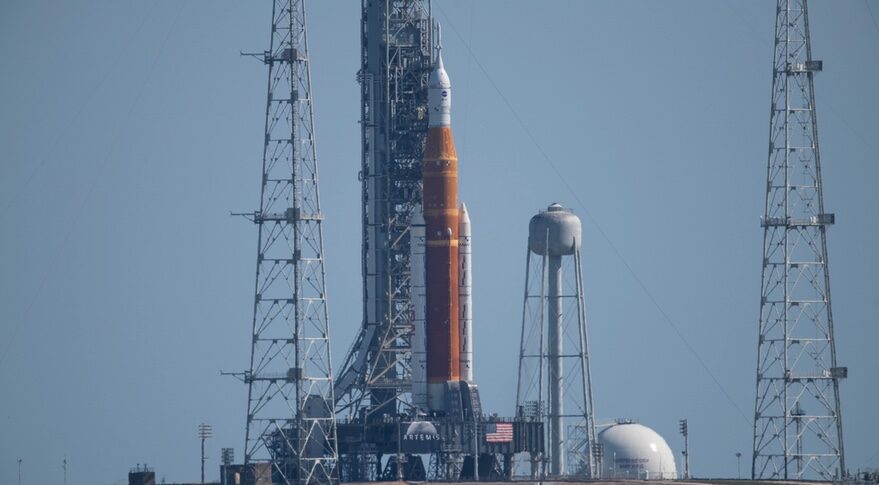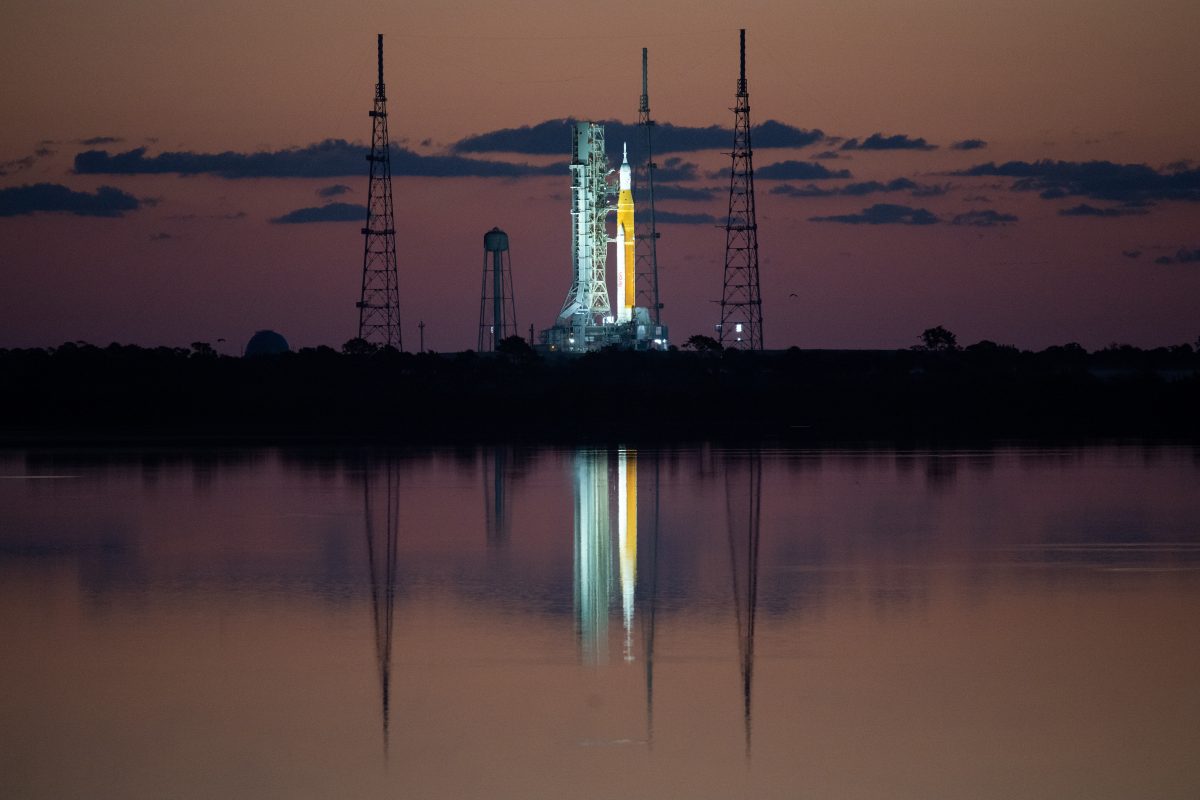
Update On NASA’s Plan For The Space Launch System
It has been decades since the last time a human stepped foot on the Moon. Thankfully, this is set to change not long from now apart of Artemis. At the core of many of these missions is SLS or the Space Launch System. In the past few months and weeks especially, the next generation launch vehicle has been very busy preparing for the first ever test flight.
Specifically, the Space Launch System has been working to complete the wet dress rehearsal. This process has been a bit more eventful than expected and is not yet fully finished. There have been some additional delays recently that have pushed back the ending of the test. Once completed SLS will be moved back to the vehicle assembly building and will go through some final checks before attempting an orbital test flight.
These current and upcoming tests are crucial for the future of Artemis and putting humans back on the Moon. NASA has been providing a lot of updates on the rocket and what to expect regarding tests and more. Here I will go more in-depth into some of the recent progress, delays, and plans for SLS and Artemis in the coming months.
Recent Updates

A lot has been happening with SLS as we get closer and closer to the first ever launch apart of Artemis 1. Thankfully, NASA has provided consistent updates regarding not only current tests such as the wet dress rehearsal but also future plans and what to expect. Throughout the early days of April, the Space Launch System began its wet dress rehearsal. This rehearsal is intended to run the Artemis I launch team through operations to load propellant into the rocket’s tanks, conduct a full launch countdown, demonstrate the ability to recycle the countdown clock, and also drain the tanks to give them an opportunity to practice the timelines and procedures they will use for launch. NASA points out that this test usually takes approximately two days, however, this has not been the case. So far it has been very eventful after multiple unique problems including lightning, ground equipment problems, valve issues, and more. These different issues continued to stop the test and force the agency to try again either later in the day or during the next available time slot. On April 7th, NASA tweeted saying, “The #Artemis I wet dress rehearsal test is slated to begin on April 9 with T-0 planned for 2:40pm ET on April 11. Teams continue to troubleshoot and refine the test schedule to account for insights gained during the previous runs and activities:” However soon after this announcement, it was once again delayed. They tweeted again a few days later mentioning, “#Artemis I Moon mission update: @NASAKennedy will conduct a modified “wet dress rehearsal” in preparation for launch with tanking operations no earlier than April 14. @NASA_SLS and @NASA_Orion will then return to the Vehicle Assembly Building.” This tweet is now practically up to date and also provides information on the test itself.
Specifically, NASA is planning to proceed with a modified wet dress rehearsal, primarily focused on tanking the core stage, and minimal propellant operations on the interim cryogenic propulsion stage with the ground systems at Kennedy. During the Artemis I uncrewed test mission of Orion and SLS, this ICPS will give Orion the big push needed to fly beyond the moon before the spacecraft returns to Earth. Built by Boeing and United Launch Alliance, the ICPS is a modified Delta Cryogenic Second Stage, a proven upper stage used on United Launch Alliance’s Delta IV family of launch vehicles. However, due to the changes in loading procedures required for the modified test, wet dress rehearsal testing is slated to resume with call to stations on Tuesday, April 12, and tanking on Thursday, April 14. They also point out that the wet dress rehearsal is an opportunity to refine the countdown procedures and validate critical models and software interfaces. The modified test will enable engineers to achieve the test objectives critical to launch success. In addition, engineers have identified a helium check valve that is not functioning as expected, requiring these changes to ensure safety of the flight hardware. Helium is used for several different operations, including purging the engine, or clearing the lines, prior to loading propellants during tanking, as well as draining propellant. A check valve is a type of valve that allows liquid or gas to flow in a particular direction and prevents backflow. The helium check valve is about three inches long and prevents the helium from flowing back out of the rocket.
While tests on SLS over the past few weeks have not been extremely smooth, it has still provided a lot of great experience for the teams working on the launch vehicle. Engineers sill accomplished several test objectives that will prepare the teams and integrated systems for launch. This includes configuring Launch Pad 39B and the mobile launcher for the test, just as it will have to be prepared for launch. Clearing personnel and equipment from the launch pad after configuration in order to proceed with propellant loading. Powering up Orion and the SLS rocket systems in launch configuration, including the solid rocket boosters, the core stage, and the interim cryogenic propulsion stage. Checking out and verifying the Orion spacecraft countdown and commanding by flight controllers at NASA Johnson Space Flight in Houston. Checking out the guidance, navigation and control system and all the integrated software that operates across the rocket, Orion, ground systems, and ground support centers including the Launch Control Center. Verifying and checking out all the range safety and systems with the range. Draining the liquid oxygen and liquid hydrogen after the test. And lastly, powering down the rocket, the spacecraft, and ground systems and putting them in a safe configuration.
All these activities are necessary for a successful launch or in the event launch controllers decide not to proceed with launch if a technical or weather issue arises during or prior to the countdown. Completing these objectives will allow NASA to use the next test opportunity to focus on executing the remaining objectives during dynamic operations, such as loading the cryogenic propellant and working through the launch countdown. Inspections after the second test showed the vent valve that prohibited the team from proceeding with loading liquid hydrogen was configured physically in a closed position, which prevented it from being commanded remotely to an open position. The valve positioning has since been corrected. Teams were also able to demonstrate their ability to work through several issues, such as severe weather, delays in getting a gaseous nitrogen supply source provided by a commercial vendor up and running, and fixing systems like fans that did not perform as expected. NASA points out that the Space Launch System, the Orion spacecraft, and the supporting ground system elements are all in excellent condition and in a configuration that supports the next opportunity.
What Is Next?

Following the upcoming modified test, the Space Launch System rocket and Orion spacecraft will return to the Vehicle Assembly Building (VAB) where engineers will evaluate the valve and replace if needed. Teams are confident in the ability to replace the valve once back in the VAB. Specifically, several days after the wet dress rehearsal, the integrated rocket and spacecraft will be rolled back to the Vehicle Assembly Building. In the VAB, technicians will extend platforms to reestablish access to several parts of the rocket and spacecraft. They will remove sensors specifically used for monitoring during the wet dress rehearsal, charge Orion and other system batteries, stow late-load cargo into Orion, and run final checkouts on several elements, among other tasks. Orion and SLS will roll to the launch pad for a final time about a week before launch. NASA will then review data from the rehearsal before setting a specific target launch date for the Artemis I launch. The first in a series of increasingly complex missions, Artemis I will provide a foundation for human deep space exploration and demonstrate our commitment and capability to extend human existence to the Moon and beyond prior to the first flight with crew on Artemis II. Assuming the upcoming tests go according to plan and NASA is able to finish the wet dress rehearsal and prepare the Space Launch System, we can expect a full launch attempt very soon. Sometime this summer likely in June or July we could see not only SLS but Orion and the ground systems work to reach the Moon for the first time.
Conclusion
After putting humans on the Moon around 50 years ago, we are getting very close to doing it once again. This is thanks to Artemis and specifically the Space Launch System, the launch vehicle responsible for transporting humans among other things to the Moon. Recently it has had a very eventful wet dress rehearsal and some delays. However, these problems have provided great experience for the teams at NASA and the agency is confident they will complete the test in only a few days. We will have to wait and see how it progresses and the impact it has on the space industry.
